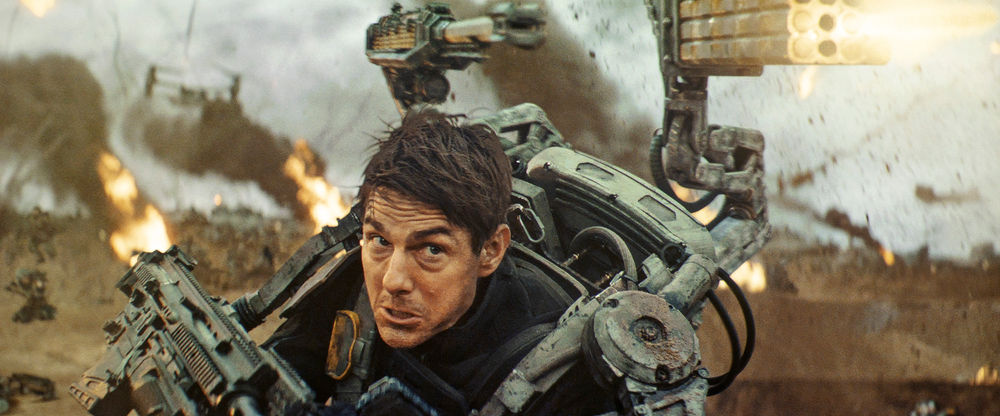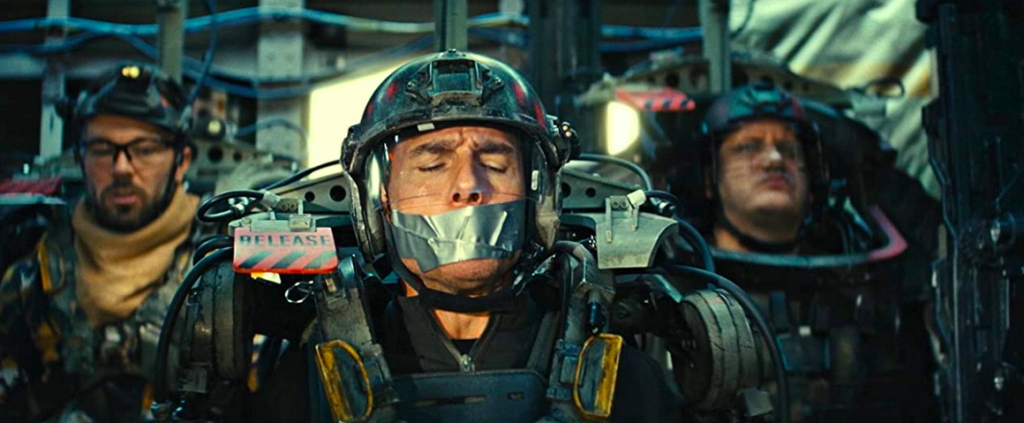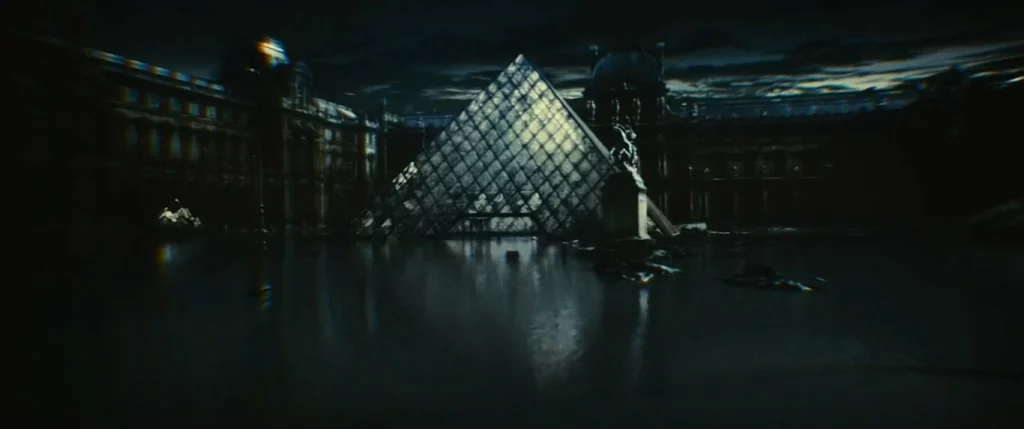| MH Rowe |

Edge of Tomorrow plays at the Trylon Cinema from Sunday, January 29 through Tuesday, January 31. Visit trylon.org for tickets and more information.
“Live. Die. Repeat.” This is one of the great movie taglines, and you have to take what pleasures you can get in the fallen world of alien-invasion blockbusters like Edge of Tomorrow (2014). It is so great a tagline, in fact, that some posters for the film featured it more prominently than its actual title. Then again, what is the title of this film? In some places you’ll see it called Live Die Repeat; in others, Live Die Repeat: Edge of Tomorrow. That the film is based on a Japanese novel with the arresting but grammatically dubious title All You Need Is Kill (2004) only complicates this matter. Live Die Repeat had been director Doug Liman’s initial preferred title, but apparently, an executive nixed the idea.1 So here we have a movie that has a mediocre title and a do-over title—which is cute, considering the plot.
What a plot it is, too. William Cage, a PR man with a supernova smile (Tom Cruise, light and fresh) works for the United Defense Force (UDF) during an alien invasion of Earth. The general of the UDF (Brendan Gleeson, bringing some surprisingly genuine gravitas) orders him to cover the attack from the front lines, hoping to add concrete realism to his booster campaign. The war is not going well; many are likely to die. PR man gets awkward, tries to say no to the general, can’t believe he has to say no to the general—he’s no fighting man, haha, no no—and finally threatens the general with bad PR. The general has him arrested and sent to the front lines anyway, only now as a man publicly labeled a deserter. On the front lines, the PR man quivers and pleads, but no matter, no one believes him, especially not his amused and righteous drill sergeant (Bill Paxton, having a lot of fun) or his surly squad of fellow soldiers. PR man has to fight in large sci-fi battle armor he’s never used (which is an unexpected stroke of cinema verité in the world of cumbersome movie costumes) and gets dropped into a PG-13 version of the D-Day scene from Saving Private Ryan. Soon enough he finds himself being repeatedly killed due to a mysterious time loop—a classic dilemma for a frustrated man. With the help of Rita Vrataski (Emily Blunt, steely and charming), who is the most famous soldier in the world and who once had the time loop power/curse herself, PR man has to get good enough at surviving the brutal battle so that he and Rita can make it all the way to the alien queen (they don’t use that phrase, but she’s hiding under the parking garage of the Louvre). Once they meet and destroy the alien queen, they have defeated the aliens by depriving them of their time-looping power, which the PR man accidentally received when he was doused in alien blood the first time he died. Simple, light, and fun!
With the plot out of the way we can talk about the true subject of this film: Tom Cruise. In Edge of Tomorrow, he is both effervescent and sweatily desperate. He plays the role of our military PR man with a lightness, exasperation, and case of nerves that enlivens the character. He makes the whole movie work.

Much was made at the time of Edge of Tomorrow’s release about its generic resemblance to video games, especially games in which a player’s character repeatedly dies before learning how to do everything right.2 The original novel, All You Need Is Kill, suggests the same parallel. The Japanese protagonist in the book does not attribute his good soldiering to innate ability or aggressive desire—he doesn’t even want to save the world. For him, being stuck in a time loop where he dies and dies and dies is only a puzzle to solve. His quest to figure it out calls to the mind the “grinding” process familiar to gamers all over the world: Repeat a task again and again, until your success and experience gains you a benefit or bonus, a treasure maybe, or a special item.
While the hero of All You Need Is Kill does draw a connection between this exercise and the discipline of samurai in Japanese history, he disavows the fighting prowess that clings to the American military figures he meets during his quick, crude adventure. His fantasies are not American, not triumphant. Perhaps appropriately, then, he doesn’t stand victorious over the alien foe at the end of the novel. He reaches instead a bittersweet turning of the tide. He’ll likely win—and he’s no longer stuck in a time loop—yet he’s alone, a killing machine committed to the grinding contest of battle.
Edge of Tomorrow puts the triumphalist pop fantasies back into the story, though only in the sense that we get to see the aliens lose. Tom Cruise gets to win and stop fighting—the dubious glory of so many action heroes, who are, after all, likely coming back in a sequel (a more profound and troubling existential time loop).
Not that he’s much of an action hero, either. Cruise begins Edge of Tomorrow in a comic mode. The scene where he tries to say no to his orders is a neat rendition of something Tom Cruise the actor does particularly well: saying thanks but no thanks, smiling, begging off, backing out of the room. As the time loop drags Cruise into dead-eyed expertise, however, the joke only gets better. By the time he is explaining to Emily Blunt exactly where they need to step and turn—where to run, stop, jump, dodge—to make it through the aliens on the beach during this iteration of the loop, you realize they’re talking about blocking, which is the process of deciding exactly where and how things in front of a camera are positioned in relation to each other. They’re not in a video game. They’re on a film set.
When Edge of Tomorrow kills Tom Cruise over and over, often in grimly slapstick ways (squashed by a truck might be my favorite), it emphasizes the sprightly amusements of apocalyptic cinema: a grin in the face of annihilation. The film appears to know exactly how ludicrous violence is in a movie like this, all the while celebrating how lightly it can be taken. I wouldn’t say it’s a comment on that gruesome violence though. It’s just the right amount of knowing.
The time loop segment of the film remains its strongest, most enduring part. Cruise and Blunt try to nail an action sequence take after take. Cruise becomes competent out of frustration and weariness, not rage or bloodlust. By the time he’s able to demand a specific set of bullets for the armor he could barely operate earlier in the film, his deadpan expression comes off as funny. Action films need a “man pushed to the edge.” He’s grim, unsmiling. This time, the edge is simply another wearying task in a life of repetitive and irritating D-Day invasions. Cruise isn’t a trained killer. He’s just hitting his goddamn marks.
I won’t say that Edge of Tomorrow redeems Tom Cruise as an actor, mostly because I think if you can look past his franchise ambitions, the articles about his death-defying stunts, Scientology, and the simple fact of his mega-fame, you’ll find a performer with supreme physical expressiveness. He knows how to use his face. There are scenes in this film where he screams and twitches with just his eyes, and scenes where his clenched body language is more emphatic than his dialogue. He can make desperation charming and charm desperate. He can seethe, and above all, he really knows how to move on camera. Edge of Tomorrow has him in a comic mode, but for a menacing example of his physical drama as an actor watch Michael Mann’s Collateral (2004).

After that first time-looping hour, Edge of Tomorrow has to find a way to wrap things up. Somehow the absurd montages of the film’s first half make its conventional ending perfect, if not exactly thrilling. Cruise and Blunt have at last reached the finale of the film, which is obliged to end the way all such movies end: by blowing up some recognizable monument of human architecture (the Louvre in this case) and murdering a bunch of hissing aliens in the process. Meanwhile, pretty much every line of dialogue you know from movies just like this one comes trotting out for a victory lap: “Let me buy you some time,” “See you in the next life,” and “We gotta go now,” all said with the utter conviction an action sequence demands.
There’s something poignantly professional about this conclusion. It’s so thoroughly predictable that you can almost feel relief that the filmmakers found a way to stick the landing. Even the tacked-on romance between Tom Cruise’s William Cage and Emily Blunt’s Rita Vrataski, however beside the point, feels full of undisguised satisfaction. They found a way to include each element of popular entertainment, they really did. A lot depends on the magnetism of Blunt and Cruise, rather than the plausibility of their romance. But in the end, they all hit their marks.
T.S. Eliot’s famous poem of apocalypse, in which the world ends with an all-too-human whimper rather than a transcendent bang, is called “The Hollow Men.” It’s better than a lot of apocalyptic films, but hollowness is a virtue in Edge of Tomorrow, which, at its best moments, achieves a lightness that could beautify any dreary dystopia. The whimpers at the end of that world are so close to laughter.
NOTES
1 Ryan Lambie, “Doug Liman Interview: The Wall, Bourne, Edge of Tomorrow 2,” DenofGeek.com, July 28, 2017, https://www.denofgeek.com/movies/doug-liman-interview-the-wall-bourne-edge-of-tomorrow-2/
2 Matt Zoller Seitz, “Edge of Tomorrow,” RogerEbert.com, June 6, 2014, https://www.rogerebert.com/reviews/edge-of-tomorrow-2014
Edited by Olga Tchepikova-Treon
